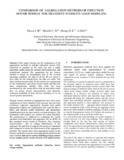| dc.description.abstract | This paper focusses on the comparison of the aggregation methods of multiple induction motors (IM) connected in parallel on the same bus into a single equivalent model using the no-load and locked-rotor and transformer method. The operation for the former method is based on assumptions that in the no-load operating condition, the slips of all the IM are equal to zero while for the locked-rotor, the slips are unity. The latter method assumes that all the motors are represented by the transformer equivalent circuit model and thus the name transformer method. This study has been necessitated by the strong effects that the non-linear loads have on power system characteristics and therefore erroneous modeling of these devices continues to be an area of greater uncertainty. Though various methods of aggregations have been used, comparison on their suitability and accuracy has not been extensively explored. Appropriate dynamic load model aggregation reduces the computation time and provides a faster and efficient model derivation and parameters
Identification that are most sensitive to load dynamics. The simulations and analysis are carried out using Simulink. The performance is validated by evaluating the results
Obtained from individual and aggregate IM on IEEE 16 Bus standard system found in literature. The transient characteristics due to voltage disturbances of the aggregate IM and that of original IM group are simulated and compared to check the effectiveness of the aggregation methods. The results shows that aggregation based on the former method is accurate than aggregation based on the latter method and can be used in modeling of large motors in any complex power system because of its high accuracy | en_US |

